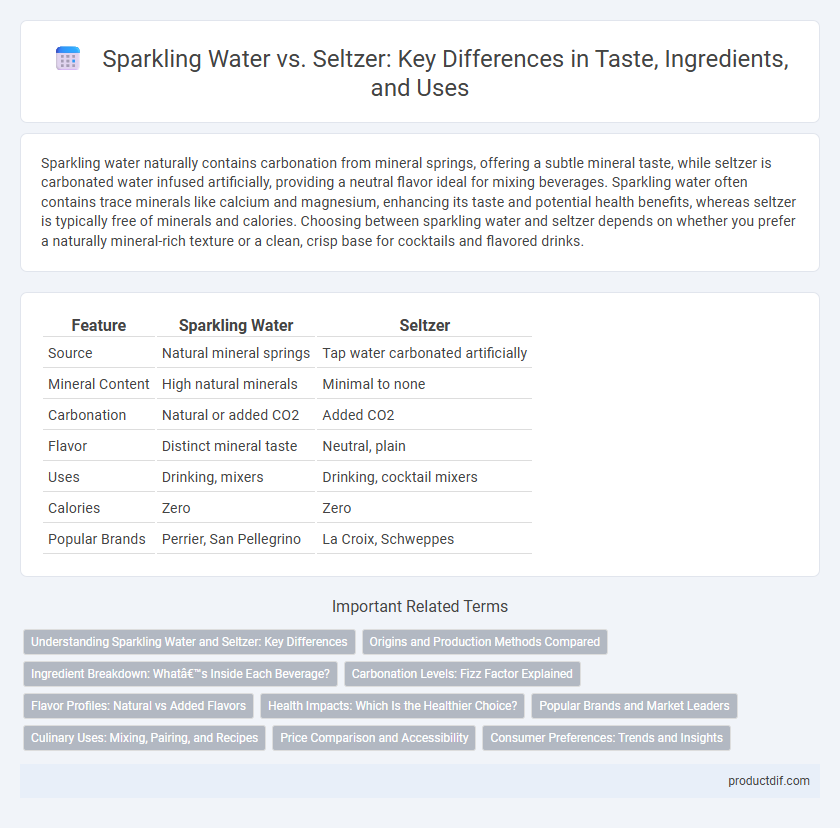Sparkling water naturally contains carbonation from mineral springs, offering a subtle mineral taste, while seltzer is carbonated water infused artificially, providing a neutral flavor ideal for mixing beverages. Sparkling water often contains trace minerals like calcium and magnesium, enhancing its taste and potential health benefits, whereas seltzer is typically free of minerals and calories. Choosing between sparkling water and seltzer depends on whether you prefer a naturally mineral-rich texture or a clean, crisp base for cocktails and flavored drinks.
Table of Comparison
| Feature | Sparkling Water | Seltzer |
|---|---|---|
| Source | Natural mineral springs | Tap water carbonated artificially |
| Mineral Content | High natural minerals | Minimal to none |
| Carbonation | Natural or added CO2 | Added CO2 |
| Flavor | Distinct mineral taste | Neutral, plain |
| Uses | Drinking, mixers | Drinking, cocktail mixers |
| Calories | Zero | Zero |
| Popular Brands | Perrier, San Pellegrino | La Croix, Schweppes |
Understanding Sparkling Water and Seltzer: Key Differences
Sparkling water contains natural minerals and carbon dioxide, resulting in a subtle mineral taste, while seltzer is simply carbonated water without added minerals, offering a neutral flavor. The mineral content in sparkling water often provides a smoother mouthfeel, whereas seltzer's lack of minerals makes it crisp and plain. Understanding these differences helps consumers choose between a naturally enriched beverage and a pure, fizzy option for hydration or mixers.
Origins and Production Methods Compared
Sparkling water, originally sourced from natural mineral springs like those in Germany's famous Apollinaris, contains naturally occurring minerals and carbon dioxide, while seltzer is artificially carbonated plain water without natural mineral content. Sparkling water production relies on bottling carbonated spring water directly from its source, preserving mineral composition, whereas seltzer is created by infusing purified tap or filtered water with carbon dioxide gas through mechanical carbonation. The distinction lies in the mineral profile and carbonation origin, with sparkling water offering natural effervescence and seltzer providing a clean, neutral taste due to its artificial carbonation process.
Ingredient Breakdown: What’s Inside Each Beverage?
Sparkling water contains carbonated water naturally infused with minerals such as calcium, magnesium, and potassium, often derived from natural springs, offering a distinct mineral taste. Seltzer is artificially carbonated water with no added minerals or flavors, making it a plain, neutral beverage. Both provide bubbles, but sparkling water's mineral content offers subtle flavor nuances compared to seltzer's clean, crisp profile.
Carbonation Levels: Fizz Factor Explained
Sparkling water contains natural carbonation or added minerals that create a finer, smoother fizz, while seltzer is artificially carbonated with a sharper, more aggressive carbonation level. The carbonation intensity in sparkling water typically lasts longer due to the natural or mineral content enhancing bubble retention. Seltzer's higher carbonation pressure produces larger bubbles that burst quickly, offering a more intense and immediate fizz experience.
Flavor Profiles: Natural vs Added Flavors
Sparkling water contains natural minerals that contribute subtle, naturally occurring flavors, often described as crisp and refreshing. Seltzer water is typically unflavored or includes added artificial or natural flavorings that create a broader range of taste options, from citrus to berry. The choice between sparkling and seltzer waters depends on whether one prefers the inherent mineral taste or the variety provided by added flavors.
Health Impacts: Which Is the Healthier Choice?
Sparkling water contains natural mineral content that can support hydration and provide essential electrolytes, while seltzer is simply carbonated water without minerals, offering hydration without added benefits. Both are calorie-free and sugar-free, making them healthier alternatives to sugary sodas, but sparkling water's mineral content may aid digestion and bone health. Choosing sparkling water can enhance nutrient intake, whereas seltzer remains a neutral, hydrating option with no additives.
Popular Brands and Market Leaders
Perrier and San Pellegrino dominate the sparkling water market with their natural carbonation sourced from mineral springs, emphasizing purity and premium taste. LaCroix and Schweppes lead the seltzer segment, offering flavored carbonated water with added essences and no sodium, catering to health-conscious consumers. Market trends show rising consumer demand for zero-calorie, naturally carbonated beverages, positioning these brands as key players in the expanding sparkling water and seltzer industry.
Culinary Uses: Mixing, Pairing, and Recipes
Sparkling water, with its natural mineral content and subtle effervescence, enhances the flavor profile of cocktails and gourmet dishes, making it ideal for mixing with premium spirits and pairing with fresh seafood or light salads. Seltzer, typically plain carbonated water without added minerals, provides a neutral, crisp fizz that complements bold flavors in cocktails, such as citrus or herbal infusions, and works well in recipes requiring a clean, bubbly texture without altering taste. Both sparkling water and seltzer serve as versatile culinary ingredients, enriching beverages and culinary creations with refreshing effervescence tailored to specific flavor pairings and recipe requirements.
Price Comparison and Accessibility
Sparkling water generally commands a higher price point than seltzer due to its mineral content and natural source claims, with prices ranging from $1.50 to $3.00 per liter compared to seltzer's typical $0.80 to $2.00 per liter. Accessibility-wise, seltzer is widely available in most supermarkets and convenience stores, often in bulk packs, making it an economical choice for regular consumption. Sparkling water, while readily found in premium grocery sections and specialty stores, tends to be less common in bulk and carries a premium positioning that can limit its accessibility for budget-conscious consumers.
Consumer Preferences: Trends and Insights
Sparkling water and seltzer have surged in popularity as consumers increasingly seek healthier alternatives to sugary sodas, with sparkling water often preferred for its natural mineral content and subtle flavors. Market trends indicate a growing demand for flavored options without added sugars or artificial ingredients, driving innovation among leading beverage brands. Consumer insights reveal a significant segment prioritizes sustainability and packaging transparency, influencing purchasing decisions in the sparkling water and seltzer categories.
Sparkling Water vs Seltzer Infographic

 productdif.com
productdif.com